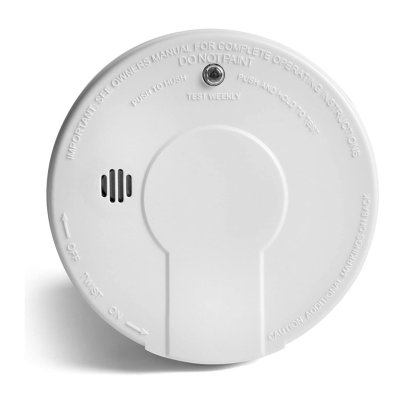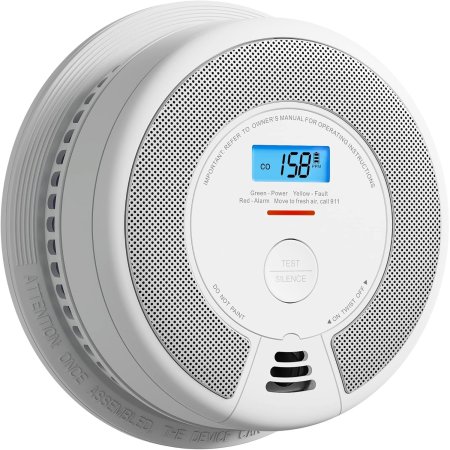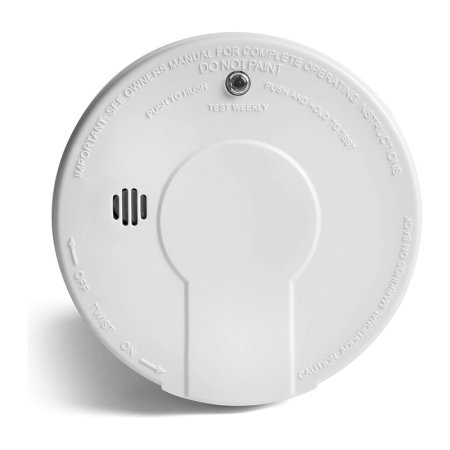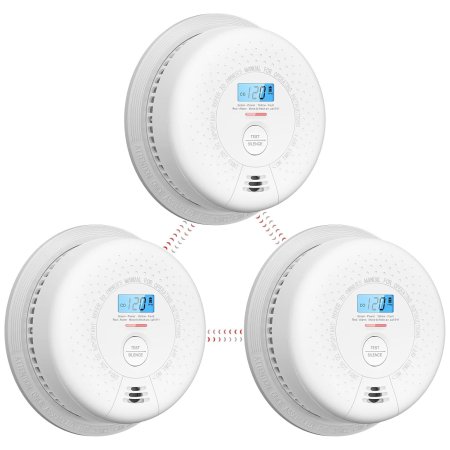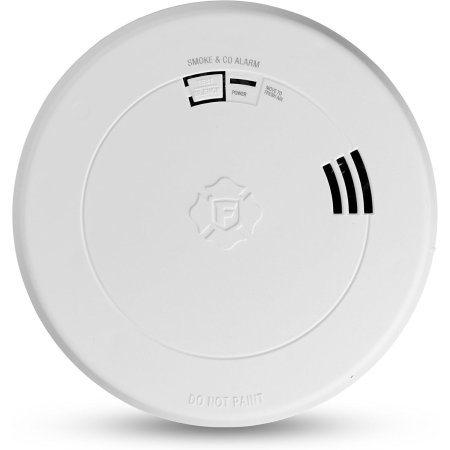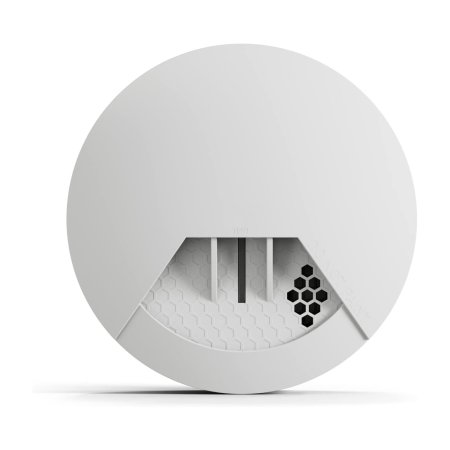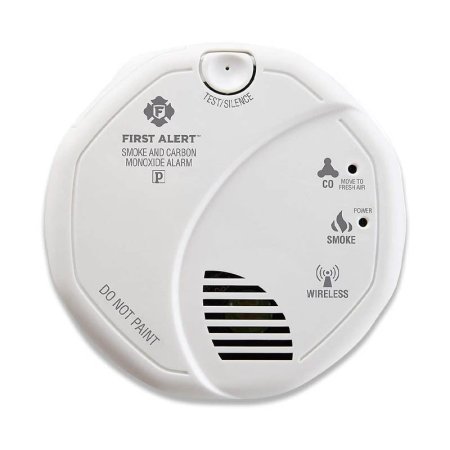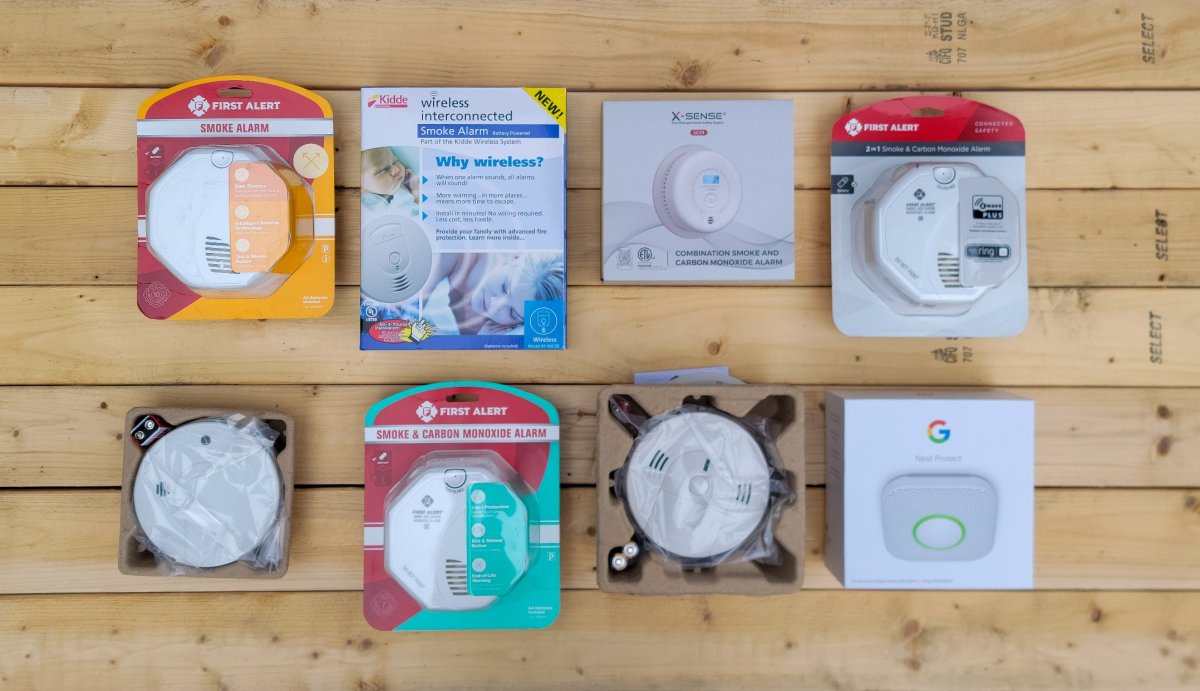
We may earn revenue from the products available on this page and participate in affiliate programs. Learn More ›
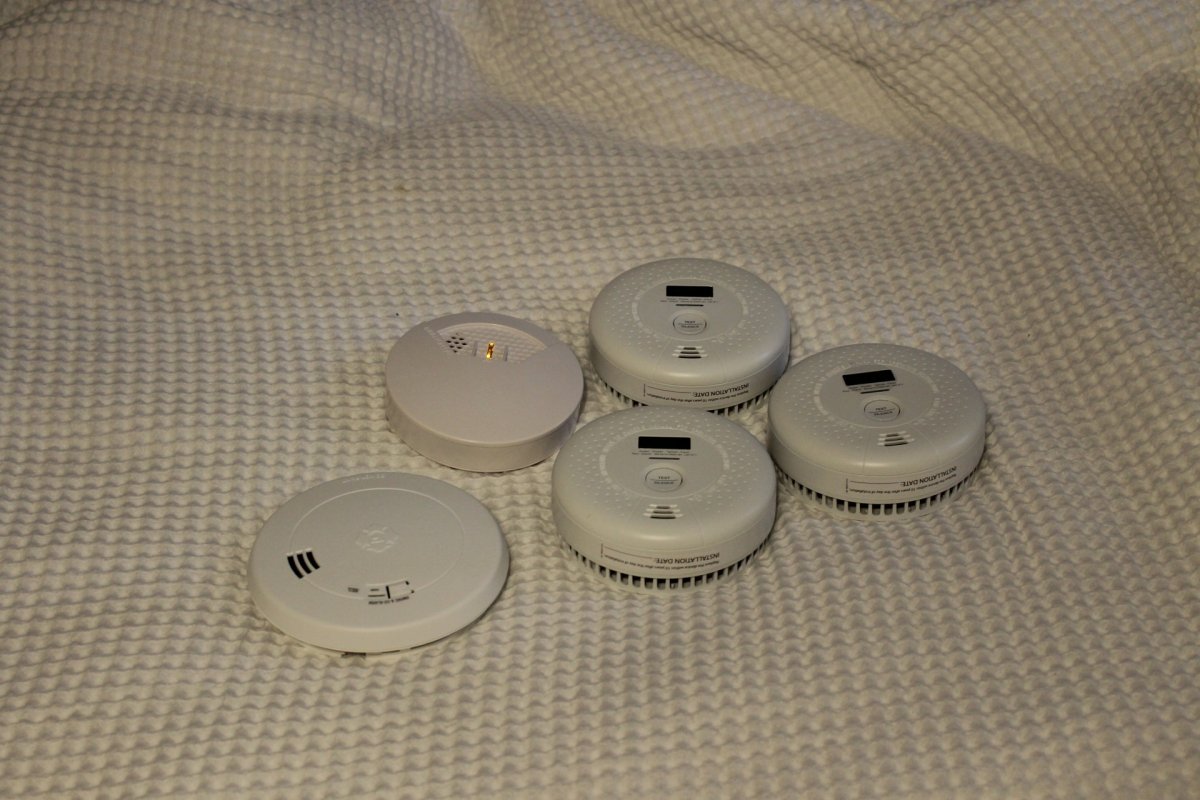
Smoke detectors are a lot like income taxes: they need to be dealt with once a year, not a whole lot of people understand them, and issues with either can be particularly, well, alarming. Simple yet necessary heroes of home safety and security, smoke detectors tend to be forgotten until they go off (a good thing) or fail to function in an emergency (a potential tragedy). A well-functioning, high-quality smoke detector is essential for every household, so we researched more than 20 top models and put 15 to the test.
Our favorite was the X-Sense SC07 Wireless Smoke & Carbon Monoxide Alarm. It monitors for smoke and carbon monoxide and has a large digital display showing the carbon monoxide parts per million. We also appreciated the slim, sleek design.
The National Fire Protection Association recommends at least one smoke detector for each floor of a home, as well as one in every bedroom. It’s important to become familiar with the types of detectors, how they operate, and some of the finer points of fire alarm technology. Read on to learn what you should look for in a smoke alarm and how we tested and selected the best smoke detectors.
- BEST OVERALL: X-Sense SC07 Wireless Smoke & Carbon Monoxide Alarm
↓ Jump to Review - BEST BANG FOR THE BUCK: Kidde i9050 Battery-Operated Smoke Alarm
↓ Jump to Review - BEST IN TECH: Google S3003LWES Nest Protect Smoke and CO Detector
↓ Jump to Review - BEST INTERCONNECTED: X-Sense Interconnected Wireless Smoke and CO Detector
↓ Jump to Review - BEST VOICE ALARM: First Alert SMCO210V Smoke & Carbon Monoxide Alarm
↓ Jump to Review - HONORABLE MENTION: SimpliSafe Wireless Smoke Detector
↓ Jump to Review - ALSO CONSIDER: First Alert Z-Wave Smoke & Carbon Monoxide Alarm
↓ Jump to Review
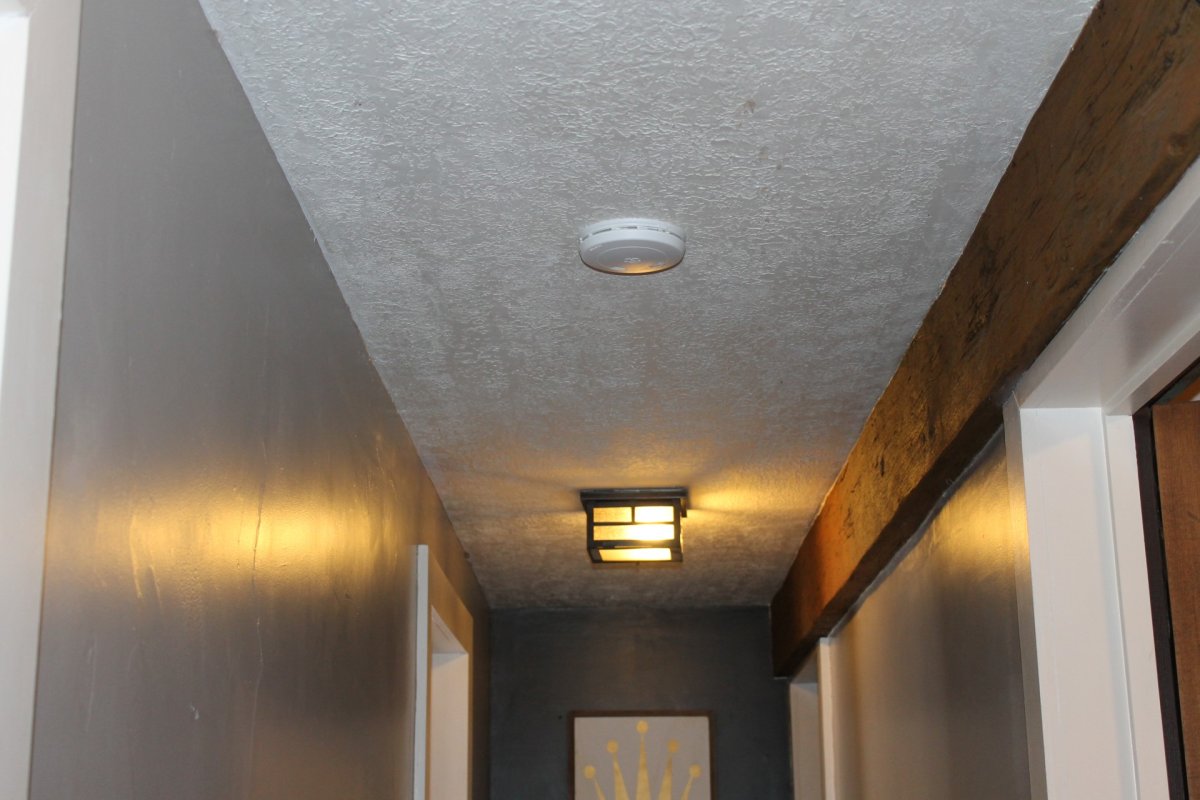
Smoke Detectors Comparison Chart
| Product | Type | Interconnect | CO Detection |
| X-Sense SC07 Wireless Smoke & Carbon Monoxide Alarm | Photoelectric (smoke) and electrochemical (CO) | No | Yes |
| Kidde i9050 Battery-Operated Smoke Alarm | Ionization | No | No |
| Google S3003LWES Nest Protect Smoke and CO Detector | Split-sensor, which acts as both photoelectric and ionization | Yes | Yes |
| X-Sense Interconnected Wireless Smoke and CO Detector | Photoelectric (smoke) and electrochemical (CO) | Yes | Yes |
| First Alert SMCO210V Smoke & Carbon Monoxide Alarm | Electrochemical and photoelectric | No | Yes |
| SimpliSafe Wireless Smoke Detector | Photoelectric | Yes, via SimpliSafe base station | No |
| First Alert Z-Wave Smoke & Carbon Monoxide Alarm | Combination photoelectric smoke and electrochemical CO | Yes, via Ring hub | Yes |
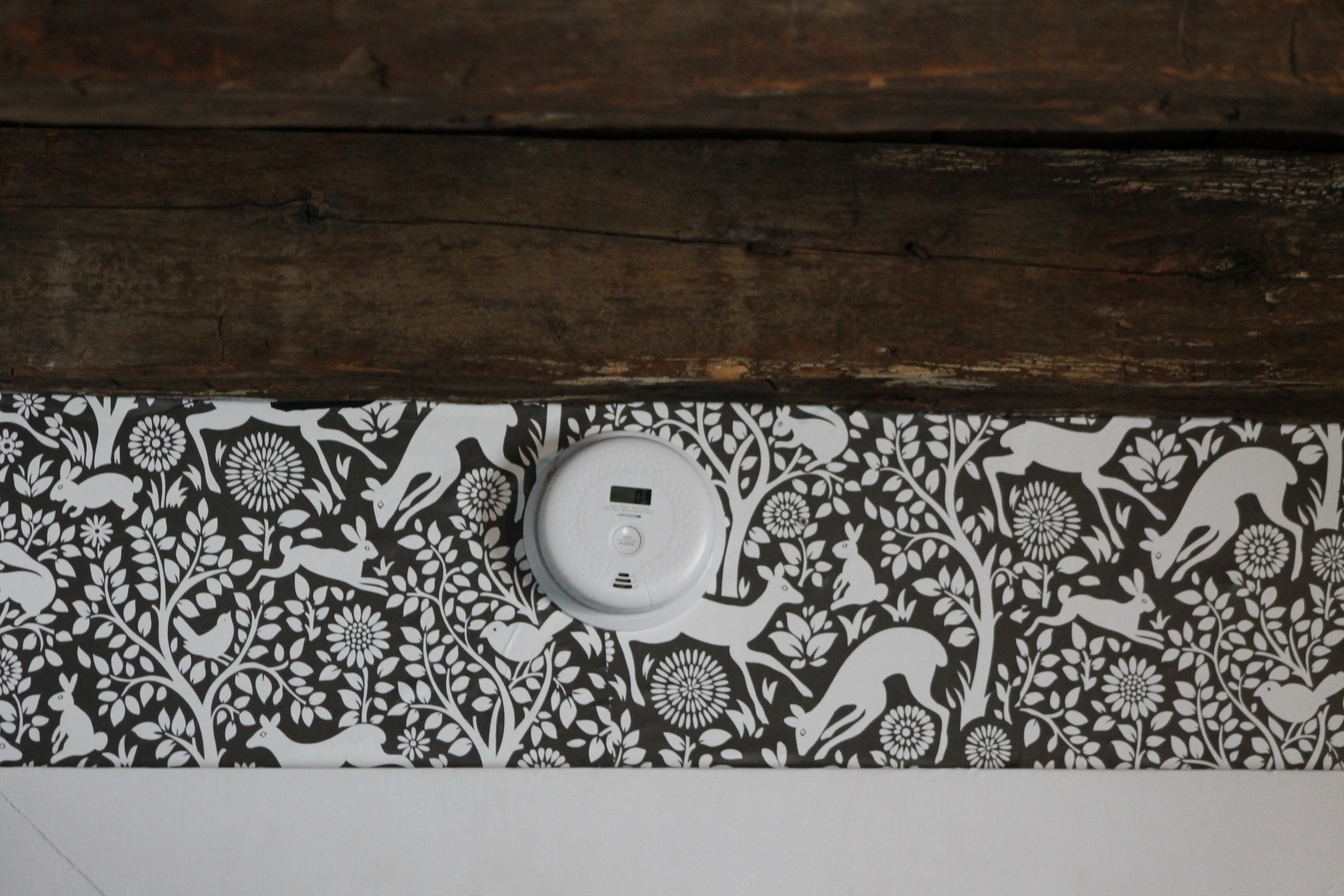
Our Top Picks
These top picks include photoelectric, ionization, and dual-sensor smoke detectors to suit a variety of different needs. All are high-quality models currently on the market that we’ve tested ourselves.
Note: All of the following products feature battery operation, making them very easy to install. They’re also all Underwriters Laboratories (UL) listed for safety.
Best Overall
X-Sense SC07 Wireless Smoke & Carbon Monoxide Alarm
What We Like
- Features a smoke and carbon monoxide sensor
- Digital display shows carbon monoxide parts per million (ppm)
- Sleek, modern design
What We Don’t Like
- Has a sometimes-faulty activation switch
Specs
- Type Photoelectric (smoke) and electrochemical (CO)
- Interconnect No
- CO detection Yes
Our Ratings: Installation and Setup 5/5; Functionality 4/5; Value 4.3/5
The X-Sense SC07 combo alarm is a two-way player that would benefit many homeowners. This model features a photoelectric sensor that detects smoke particles and an electrochemical sensor that detects the presence of carbon monoxide. It also has a digital display that shows the carbon monoxide parts per million (ppm) in the air as well as the battery’s status. This lends a sleek design that will easily fit in with modern spaces.
The real star of the show is the display, which clearly indicates the level of carbon monoxide in the air when it’s more than 30 ppm (if it’s under that amount, it registers as 0). While a sensor capable of reading lower levels would be better, we still find this reassuring.
We’re not, however, a big fan of this model’s activation switch. While it worked perfectly on the model we tested, we have broken that switch on previously tested X-Sense models, so we would still caution users to be very gentle with it. Otherwise, we felt this was the best overall smoke detector. Plus, an interconnected version is available.
What our tester says: “This device triggered within 10 seconds during testing—an impressively fast response—though it did take a while to silence.”—Tom Scalisi, Product Reviews tester and writer
Get the X-Sense SC07 smoke detector at Amazon or X-Sense.
Best Bang For The Buck
Kidde i9050 Battery-Operated Smoke Alarm
What We Like
- Affordable price point
- Loud alarm is audible throughout the home
- One of the easiest models to silence
What We Don’t Like
- 10 seconds slower to alert than other devices
Specs
- Type Ionization
- Interconnect No
- CO detection No
Our Ratings: Installation and Setup 3/5; Functionality 4/5; Value 4.3/5
A hardwired, Wi-Fi, or interconnected fire alarm system can be expensive, but thanks to the affordable price of the Kidde i9050, users can equip their entire home with smoke detectors without zeroing out their bank accounts. Powered by a 9-volt battery, this basic ionization-style model is hardly a high-tech option, but it’s a reliable choice for smoke detection.
Considering the budget-friendly price, we were skeptical about how well this alarm would perform during testing. While it did perform roughly 10 seconds slower than other devices, its alarm sounded within 25 seconds, and the siren was loud. Also, we were able to silence this alarm much faster than devices that cost four times the price. It truly offers the best value for dollar of any detector on the list, though it doesn’t offer many special features.
Get the Kidde i9050 smoke alarm at Amazon or Walmart.
Best in Tech
Google S3003LWES Nest Protect Smoke and CO Detector
What We Like
- Crystal-clear voice alerts
- Reports to a phone app
- Better looking than other detectors
- Dual-sensor smoke alarm
What We Don’t Like
- Tricky to connect the device to the app
- Must keep app updated
Specs
- Type Split-sensor, which acts as both photoelectric and ionization
- Interconnect Yes
- CO detection Yes
Our Ratings: Installation and Setup 2/5; Functionality 5/5; Value 4.7/5
Equipped with the latest technology, Google’s Nest Protect smoke and carbon monoxide alarm ties into existing hardwired systems and features Wi-Fi communication. Users can program the alarm so it will indicate the location in the home where an alarm is being triggered via both the Nest app and the built-in speaker. It uses dual-sensor technology to detect both smoldering burns and flaming fires.
In our tests, we found the Nest Protect’s voice activation to be clear and the alarm to be fast. We also liked the appearance of this Wi-Fi smoke detector and appreciated that the baseplate offers quite a bit of rotational adjustment to ensure that it is straight when installed. Connecting the detector to the Nest app took a couple of tries, though.
There’s a larger caveat regarding this smart smoke alarm and similar models that work with smart-home systems: Their compatibility with those systems depends on app updates, which means users must remember to keep up-to-date on apps. If the app is an old version, the detectors might fail to communicate with a smartphone or central monitoring service.
Get the Google smoke detector at Amazon, The Home Depot, or Best Buy.
Best Interconnected
X-Sense Interconnected Wireless Smoke and CO Detector
What We Like
- Crystal-clear voice alerts
- Reports to a phone app
- Better looking than other detectors
- Dual-sensor smoke alarm
What We Don’t Like
- Tricky to connect the device to the app
- Must keep app updated
Specs
- Type Split-sensor, which acts as both photoelectric and ionization
- Interconnect Yes
- CO detection Yes
Our Ratings: Installation and Setup 5/5; Functionality 3.3/5; Value 5/5
Interconnected smoke detectors communicate with each other through a wireless signal; once one goes off, they all go off. Connecting them can sometimes be confusing, so we appreciated this three-pack from X-Sense that came interconnected—no app or Wi-Fi needed. Activation was as simple as installing the mount on the wall and attaching the smoke detectors by turning them clockwise.
These X-Sense detectors alert to smoke and dangerous levels of carbon monoxide. The digital display shows the CO levels in ppm and along with the battery level. Fortunately, these smoke detectors each come with a sealed lithium-ion battery that lasts up to ten years and the unit will notify when the battery life has ended, so you won’t have to worry about replacing batteries.
Through testing, we discovered one downside to these smoke alarms: They didn’t alert when we tested them with canned synthetic smoke. Instead, we had to set them off by blowing out a candle, which we held about three feet away. We had installed one of these smoke detectors in our basement, one on our first floor, and another on our second floor. When we set off the alarm on the first floor, all three smoke detectors loudly alerted us. Silencing them was as easy as pressing a button on the alerted detector.
Get the X-Sense interconnected smoke detectors at Amazon.
Best Voice Alarm
First Alert SMCO210V Smoke & Carbon Monoxide Alarm
What We Like
- Comes with a 10-year sealed battery
- Features a loud alarm and voice alerts
- Attractive, slim design
What We Don’t Like
- Test/silence button is very stiff
Specs
- Type Electrochemical and photoelectric
- Interconnect No
- CO detection Yes
Our Ratings: Installation and Setup 5/5; Functionality 4.3/5; Value 4/5
In addition to a loud beeping alarm, First Alert’s SMCO210V smoke and carbon monoxide detector is equipped with voice alerts that relay the location and type of alarm (smoke or CO). This smoke detector has a simple interface with one test/silence button, and programming its location took us less than two minutes. We also appreciated the sealed battery, which lasts up to ten years before the unit needs replacement.
This First Alert smoke detector was one of the loudest we tested. We put it in an upstairs hallway and could hear the beeping alarm from our basement, two floors below. When sprayed with our test can of synthetic smoke, the alarm alerted in less than 15 seconds.
There was only one thing we didn’t like: The test/silence button was very hard to push. It took us a few tries to silence the alarm after we set it off, simply due to the stiffness of the button.
What our tester says: “This smoke and carbon monoxide detector was one of my favorites. The alarm was loud and the voice alerts were clear, letting me know the location and type of threat.”—Katie Barton, Product Reviews tester and writer
Get the First Alert SMCO210V smoke detector at Amazon, Target, Walmart, or First Alert.
Honorable Mention
SimpliSafe Wireless Smoke Detector
What We Like
- Easy-to-use interface
- Quick to silence
- Compatible with SimpliSafe app and monitoring plan
What We Don’t Like
- Smoke alarm could be louder
Specs
- Type Photoelectric
- Interconnect Yes, via SimpliSafe base station
- CO detection No
Our Ratings: Installation and Setup 5/5; Functionality 4/5; Value 4/5
The SimpliSafe wireless smoke detector can be used in two ways. First, it can be used as a standalone smoke detector without owning other SimpliSafe products. It’s easy to set up, and during testing, the alarm sounded when synthetic smoke was sprayed nearby without having it connected to any other SimpliSafe products. Second, SimpliSafe users can connect it to their app and base station.
When connected to a SimpliSafe system, this smoke detector sends real-time alerts through the app and triggers the base station alarm. With optional SimpliSafe monitoring, fire rescue can be dispatched even if the user is away from the home.
Unfortunately, this model doesn’t monitor CO levels like many similarly priced smoke detectors. We also thought its alarm was a little on the quiet side. Still, it’s a good fit for those who already utilize SimpliSafe security products.
Get the SimpliSafe smoke detector at Amazon or Best Buy.
Also Consider
First Alert Z-Wave Smoke & Carbon Monoxide Alarm
What We Like
- Easy to install
- Loud enough to hear throughout the home
- Fastest activation of our test group
What We Don’t Like
- Requires Ring hub for full features and connectivity
Specs
- Type Combination photoelectric smoke and electrochemical CO
- Interconnect Yes, via Ring hub
- CO detection Yes
Our Ratings: Installation and Setup 4/5; Functionality 3.7/5; Value 4.3/5
For those who want to set up their own interconnected system that they can access from a phone and other devices, First Alert’s Z-Wave smoke detector and carbon monoxide alarm is worth considering. This combination smoke detector interfaces with the Ring Alarm hub and app, offering users real-time alerts wherever they have internet service. This unit features a photoelectric smoke sensor and an electrochemical carbon monoxide detector to alert under a variety of conditions.
Like most First Alert devices, the Z-Wave alarm was very easy to install. The audible alarm was very loud and activated faster than it took to reach for our stopwatch. The only issues we experienced when testing were its refusal to silence (a common problem with First Alert), and, obviously, if you don’t have a hub, this will only work as a basic combination detector.
Get the First Alert Z-Wave smoke detector at Amazon, Lowe’s, or Bed Bath & Beyond.
ALSO TESTED
A smoke detector should be easy to use, loud enough to alert household residents, and quick to alert in the case of smoke or detected carbon monoxide. Unfortunately, not all of the smoke detectors we tested met these thresholds.
- The Ring Alarm Smoke & CO Listener is a nice idea in theory, but we didn’t find it practical for the average homeowner.
- The Kidde P4010LDCS-W Smoke Alarm was impossible to set up. It’s designed to link to the Kidde app via Bluetooth but would not register on any of the devices that we tried.
- First Alert’s Hardwired LED Strobe Light Smoke Alarm was a big disappointment, especially for the cost. Despite numerous attempts, we couldn’t get the strobe to light.
Jump to Our Top Picks
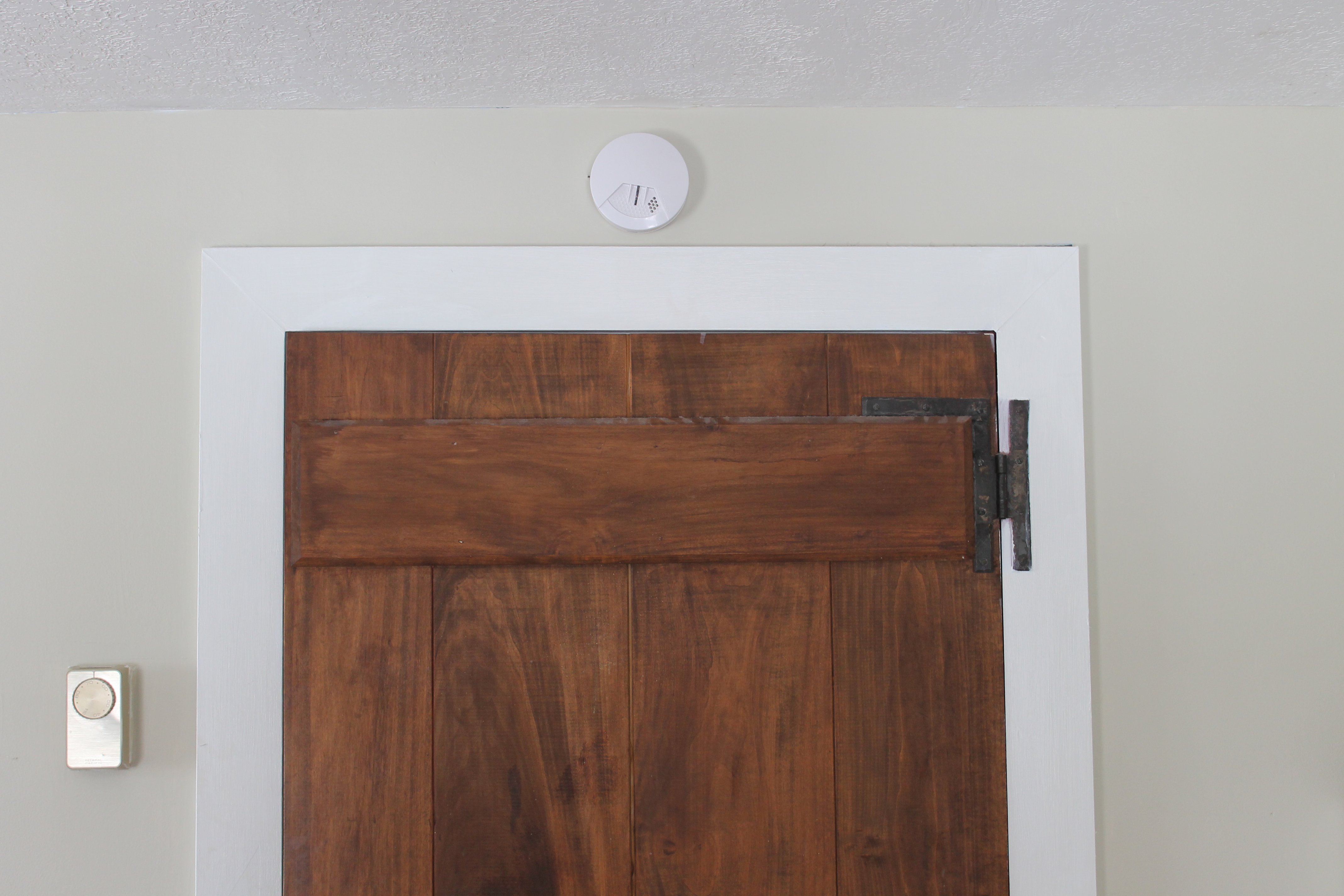
How We Tested the Best Smoke Detectors
| Products tested | 15 |
| Time spent testing | 3 weeks |
| Tests performed | 4 |
| Price range | $20 to $150 |
While pressing the “test” button is a perfectly fine way for folks to perform once-a-month testing on a smoke detector, a simple button test cannot tell the whole story of how well a unit will perform. A lot more went into our testing, including nearly a decade of experience working with commercial fire alarms.
After researching more than 20 top-rated smoke detector models, we chose 15 to test, not all of which made our final list. We installed each of these units individually, according to the directions, to determine how easy they were to set up. We also tested each device by spraying two puffs of canned synthetic smoke—the same type used when testing fire alarms professionally. We timed each to get a solid sense of how long activation took, and then we compared the results.
We used a standardized rubric to keep track of our testing results, rating each smoke detector on a scale of 1-5 based on installation, setup, functionality, and value metrics. At the end of testing, we tallied these results to find the winners.
| Installation and Setup | Functionality | Value | |
| X-Sense SC07 Wireless Smoke & Carbon Monoxide Alarm | 5/5 | 4/5 | 4.3/5 |
| Kidde i9050 Battery-Operated Smoke Alarm | 3/5 | 4/5 | 4.3/5 |
| Google S3003LWES Nest Protect Smoke and CO Detector | 2/5 | 5/5 | 4.7/5 |
| X-Sense Interconnected Wireless Smoke and CO Detector | 5/5 | 3.3/5 | 5/5 |
| First Alert SMCO210V Smoke & Carbon Monoxide Alarm | 5/5 | 4.3/5 | 4/5 |
| SimpliSafe Wireless Smoke Detector | 5/5 | 4/5 | 4/5 |
| First Alert Z-Wave Smoke & Carbon Monoxide Alarm | 4/5 | 3.7/5 | 4.3/5 |
What to Consider When Choosing a Smoke Detector
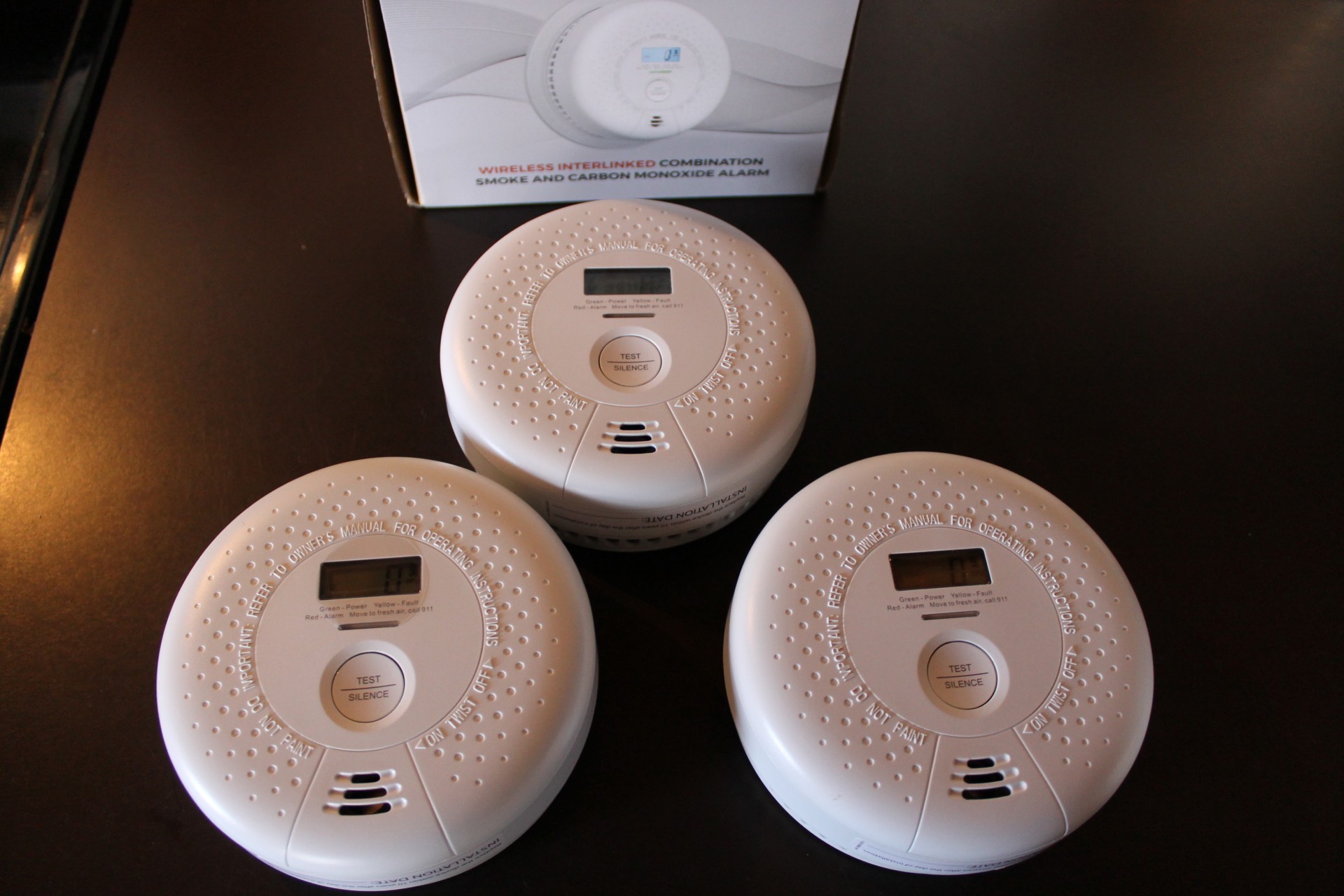
Even if tested annually, a smoke detector has an operational lifespan of only 10 years. Any model older than that should be replaced, regardless of its working condition. To help make an informed decision, learn about the following key features that pop up when considering the wide range of models currently on the market.
Types of Smoke Detectors
There are three main smoke sensor types: photoelectric, ionization, and dual sensor. While they all do the same job, they go about it differently.
Photoelectric
The chamber of a photoelectric smoke detector contains an LED light, which shoots a beam across the chamber, and a sensor that sits approximately 90 degrees from the LED. Under normal conditions, the sensor can’t “see” the LED beam, but when smoke enters the chamber, the light reflects off smoke particulates, and the sensor detects the beam.
The instant the sensor detects the beam, the alarm activates. Photoelectric smoke detectors are most effective at detecting smoldering burns—barely burning fires that can, frighteningly, smolder for days before becoming a bigger issue.
Ionization
Though these detectors employ radioactive materials, alpha rays, and other seemingly sci-fi–inspired technology, they operate in a fairly simple way. A chamber fills with tiny particles called ions, which are held in place by electrical charges. A sensor in the chamber knows how many ions are contained within. When smoke enters the chamber, it removes some of the ions, affecting the sensor’s count and sounding the alarm.
Ionization smoke detectors are most effective against fires that are actively flaming.
Dual Sensor
Just as the category name suggests, these detectors use both types of sensors. There’s no winner in a race against photoelectric and ionization detectors, and they each have their own strengths. The use of both sensor types means faster detection of threats across the range of different materials that could be burning.
Hardwired vs. Battery Operated
Battery-operated models, which tend to cost less, are usually stand-alone detectors. This means an activated smoke detector cannot alarm a monitoring system or other sensors in the home; only the detector in the smoky area will sound an alarm. The exception would be battery-operated models that are part of a home security system.
Hardwired smoke detectors connect directly to the home’s electrical system. When one detector sounds an alarm, typically, all of the detectors follow suit. While this may make it harder to pinpoint the unit that actually detected the potential fire, it alerts everyone in the house to danger.
Most residential hardwired home safety systems use battery backups, so even if the power goes out, the home will still have some fire safety protection—and that’s the best of both worlds. In commercial applications, things work a bit differently in that the fire alarm panel will rely on the batteries to keep the alarm system live until the generators kick on or the power comes back.
Interconnectivity
Briefly touched upon above, interconnectivity refers to smoke detectors’ ability to “talk” to each other, alerting the entire system to potential danger. For example, if there were an electrical fire within the car in an attached garage sensed by an interconnected detector, the entire system throughout the house would activate immediately.
Fires can double in size every 60 seconds, so if residents were to be sleeping on the other side of the house, they might not hear a stand-alone detector activate in the garage. Interconnected detectors would make them aware of the threat—hopefully before it’s too late to react.
Carbon Monoxide
In a similar circumstance, a car left running in the garage can produce fatal levels of carbon monoxide (CO), which could prove particularly dangerous to folks sleeping in a bedroom above. Smoke detectors with carbon monoxide sensors add another level of safety. While all homes should have carbon monoxide alarms, homes with gas or oil heat and hot water are particularly vulnerable to carbon monoxide buildup. If you don’t have a plug-in CO detector, a dual smoke detector with a built-in carbon monoxide detector is a wise purchase.
Monitoring
Interconnected detectors are often part of a monitored home security system. The great benefit of these systems is they can alert the local fire department, even if no one is at home to make the emergency call. A carbon monoxide issue could render those inside unable to call the fire department, so the monitoring company can make that call, possibly saving lives.
UL Listing
Quality smoke detectors are UL listed. This certification ensures that the detectors meet Underwriters Laboratories’ (UL) stringent testing requirements. Given the importance of purchasing the best smoke detector system that a household can afford, it’s not worth the risk to install anything that isn’t UL listed.
Smart Features
For those interested in the latest fire safety technology, some good smoke alarms do boast smart features. Many of these smart smoke detectors not only communicate with an overseeing alarm system but also with users’ phones through Wi-Fi. Some models even allow users to employ any TV remote to mute an activated detector.
FAQs
Now that you know a bit more about the best smoke detectors, some questions may still pop up. Here are answers to some of the most frequently asked questions, so check below for the information that will clarify your queries.
The U.S. Fire Administration states that you should test your smoke detectors monthly and replace the batteries at least once a year, unless the unit has a sealed battery—but if that’s the case, it’s still important to test the unit.
The National Fire Protection Association recommends that homes should have smoke detectors installed in every bedroom, a common area outside the sleeping area, and on every level (including the basement and attic). Placing a detector in the garage is also a good idea.
Smart smoke detectors provide a bit of extra awareness, particularly if no one is at home when the problem occurs. However, they’re not necessarily better than standard units. Some would suggest that the best option is to have a wired smoke alarm connected to a central monitoring service.
Most smoke detectors feature dual-purpose test and “hush” buttons that will allow the user to test their detector’s functionality but also stop it from sounding an alarm. However, if your smoke detector is simply beeping, it probably just needs a battery change or may be indicating that the unit’s lifespan has ended.
It’s recommended that 9-volt smoke detector batteries be changed yearly. However, lithium and sealed lithium batteries may last 5 to 10 years, depending on the type. Smoke detector beeping indicates that it’s time to change replaceable batteries or replace units with sealed batteries.
Use a can of compressed air to blow dust out of a smoke detector’s vents and away from the sensor. If you don’t have compressed air, use a vacuum to suction the dust. Then, wipe the outside of the detector with a dry dusting rag.
Put smoke detectors on the ceiling or high up on the wall, within 12 inches of the ceiling. Heat and smoke rise, so placing them lower could cause them to fail to detect a problem.
Hardwired smoke detectors run off electricity rather than batteries, relying on battery backups when the power goes out. They also often communicate with each other, meaning when one alarm sounds, they all do. Because of these features, many consider them better than standalone battery-operated smoke detectors.
Meet the Testers
Katie Barton is a home improvement writer with over ten years of experience. She extensively tests products to help readers find the best value and features for their money.
Tom Scalisi is a full-time DIY and construction writer for many of the largest websites in the industry. He spent years in the fire safety industry, both installing and testing commercial fire alarm and suppression systems.

